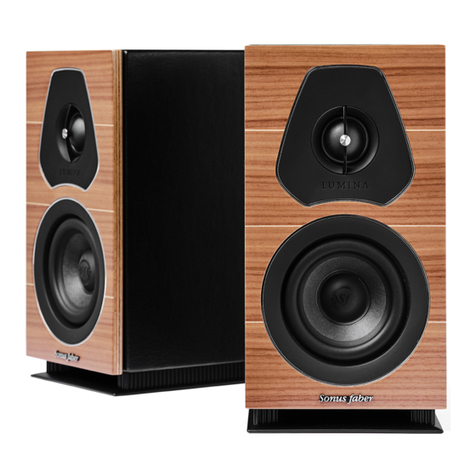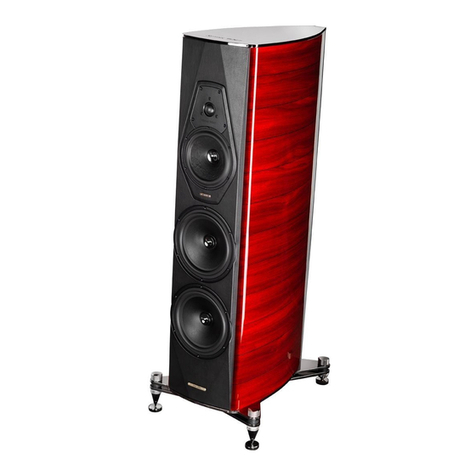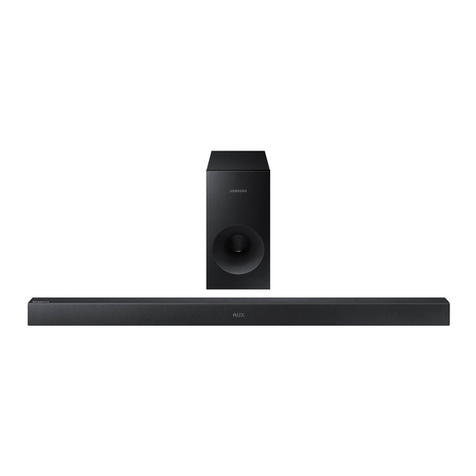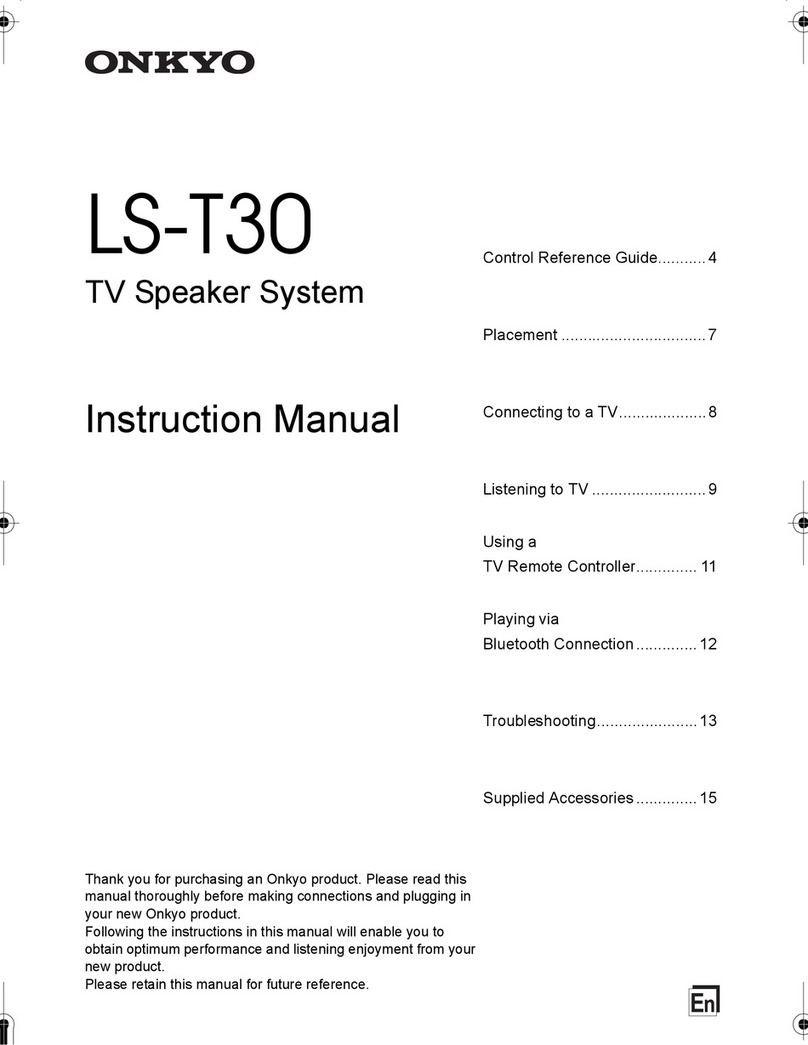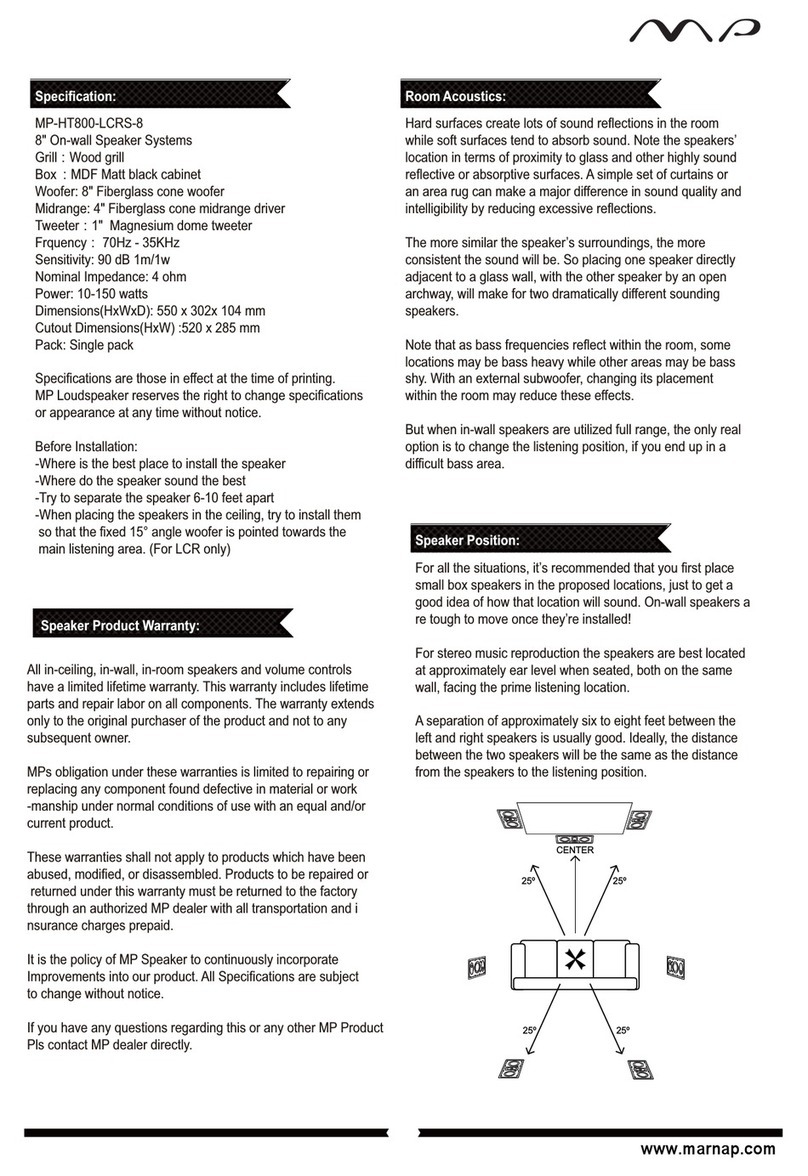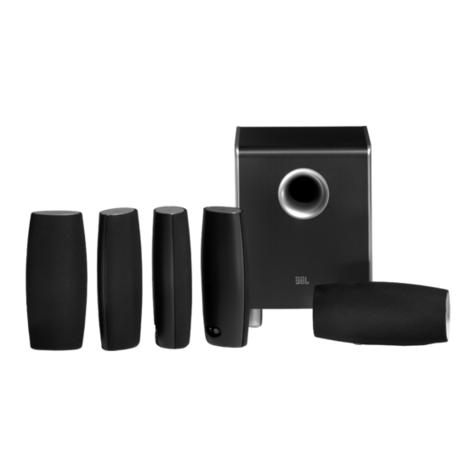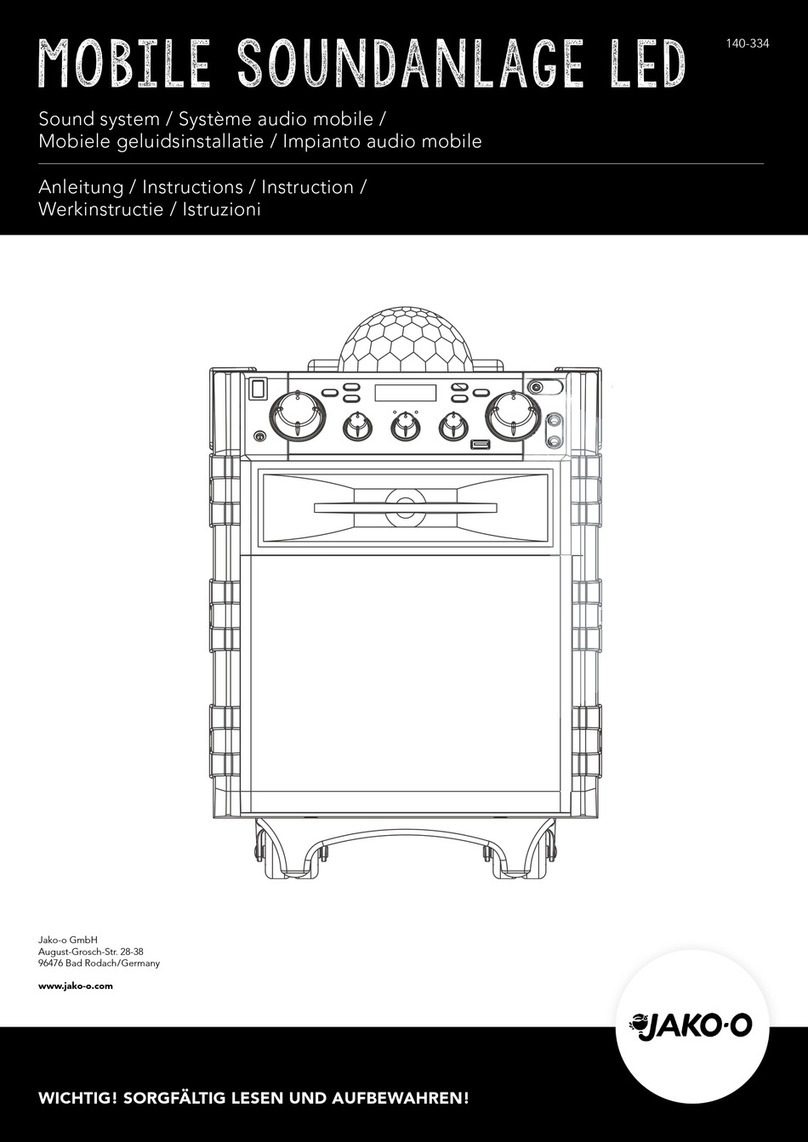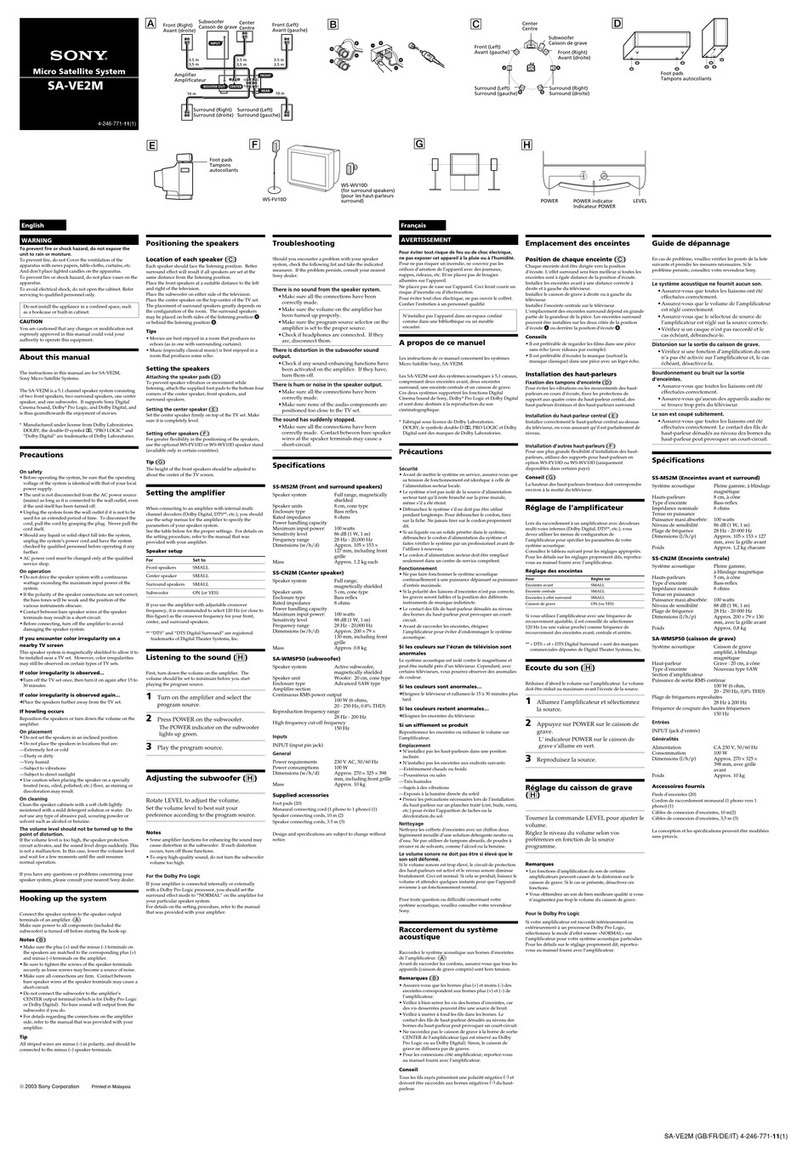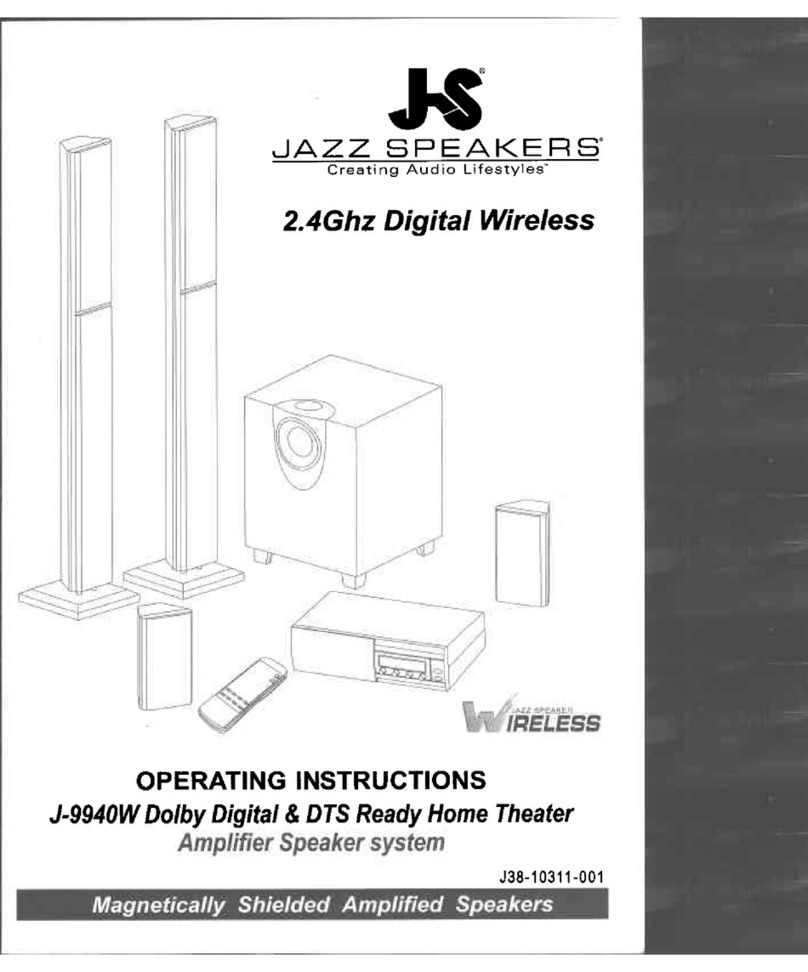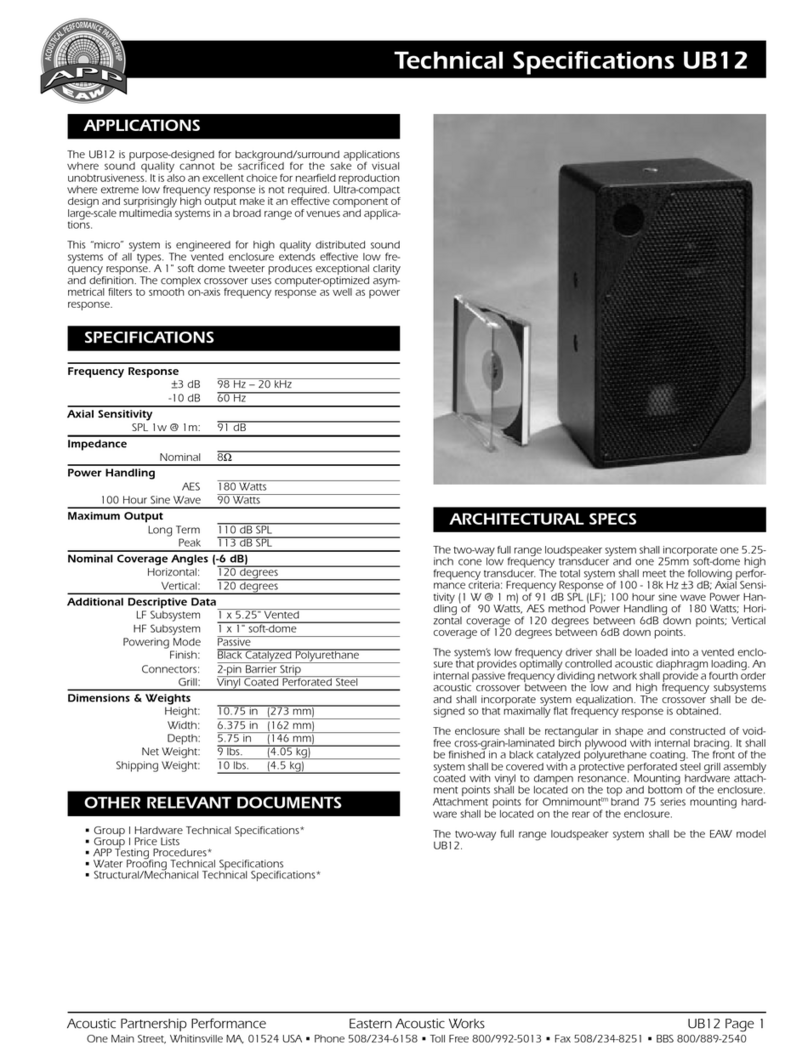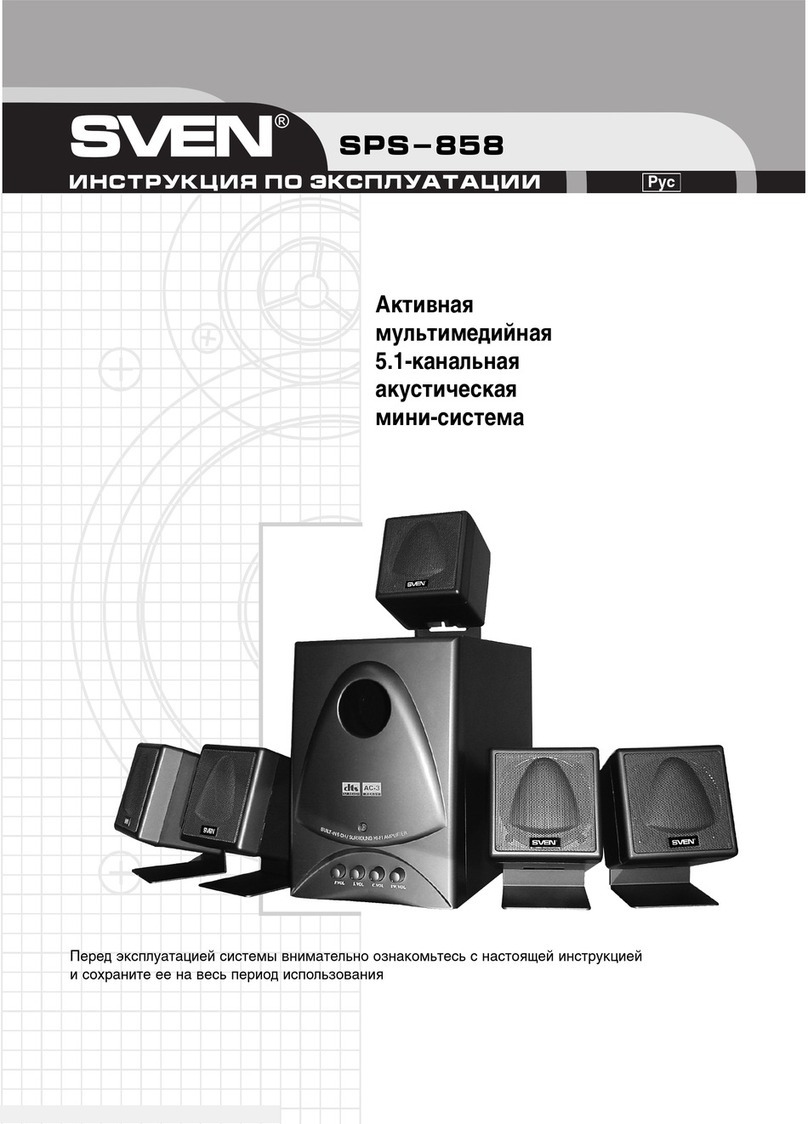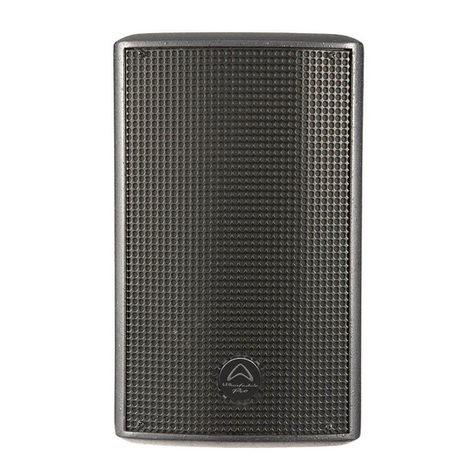Sonus Faber Venere S User manual



Gentile Cliente,
desideriamo ringraziarLa e complimentarci con Lei per aver acquistato i diffusori della Linea Venere per
l’ascolto della sua Musica preferita o per un impiego audio-video.
I diffusori della Linea Venere sono pensati per procurarLe immediatamente la massima soddisfazione,
ma poiché è nostro preciso interesse che Lei ottenga il miglior risultato possibile nell’ascolto e che
ciò avvenga nella piena sicurezza, La invitiamo a leggere attentamente, prima dell’installazione, questo
manuale d’istruzioni.
Qualora dovessero sorgerLe dubbi o curiosità, Le consigliamo di rivolgersi al personale tecnico del
punto vendita o prendere contatto direttamente con Sonus faber.
Infine Le suggeriamo vivamente di registrarsi on-line sul sito www.sonusfaber.com: in questo modo verrà
informato da Sonus faber di tutte le novità, iniziative ed eventuali promozioni.
Buona Musica!
Dear Listener,
Thank you and congratulations on your purchase of speakers from the Venere series by Sonus faber.
Your new speakers have been designed to provide you many hours of listening enjoyment for both music
as well as home theatre.
For the best results, please read this manual completely for operation instructions as well as any safety
measures to be noted during assembly and installation.
Should you have any doubts or inquiries, please contact your salesperson, or contact Sonus faber directly.
Finally we highly recommend that you registers online at www.sonusfaber.com in order to be kept
informed of all Sonus faber news, initiatives and promotions.
Enjoy your music!
Wir bedanken uns bei Ihnen und gratulieren zum Kauf eines Lautsprechers der Venere-Baureihe zum
Hören Ihrer Lieblingsmusik oder von Audio/Video-Quellen.
Lautsprecher der Venere-Baureihe wurden konzipiert um höchstmögliche Zufriedenheit zu vermitteln.
Es ist uns aber sehr wichtig, dass Sie die bestmöglichen Hörergebnisse erhalten und dieses auch in
vollkommener Sicherheit geschieht, daher lesen Sie bitte vor der Installation die Bedienungsanleitung
sorgfältig durch.
Sollten Sie irgendwelche Zweifel haben oder etwas unklar sein, dann kontaktieren Sie bitte das technische
Personal beim Händler, oder auch direkt Sonus faber.
Wir empfehlen Ihnen dringend, sich online bei www.sonusfaber.com anzumelden, um über alle
Neuigkeiten, Aktionen und Veranstaltungen von Sonus faber informiert zu werden.
Genießen Sie Ihre Musik!
Cher client,
Nous vous remercions d’avoir choisi les enceintes acoustiques de la gamme Venere pour écouter votre
musique préférée ou pour votre cinéma à domicile.
Les enceintes acoustiques Venere sont conçues pour vous procurer immédiatement le maximum de
satisfaction, mais puisque qu’il est de notre intérêt que vous obteniez le meilleur résultat possible lors de
l’écoute, et que ceci ait lieu en pleine sécurité, nous vous invitons à lire attentivement le présent manuel
d’instructions avant l’installation.
En cas de doute ou pour toute question, nous vous conseillons de vous adresser au personnel technique
du point de vente ou de contacter directement Sonus faber.
Enfin, nous vous conseillons vivement de vous enregistrer en ligne sur le site www.sonusfaber.com. De
cette façon, Sonus faber pourra vous tenir informé de toutes les nouveautés, les initiatives et les offres
Bonne musique!

ITALIANO
Progetto
Il compito di un diffusore acustico è quello di
evocare l’evento sonoro originale facendolo
rivivere ed essere capace di donare le stesse
emozioni che proviamo quando ascoltiamo
un’orchestra sinfonica, una rock-band, un trio
jazz o una colonna sonora di grande impatto.
Ecco perché noi di Sonus faber concepiamo i
nostri diffusori come Strumenti Musicali e siamo
convinti che il buon suono dipenda, in larga
misura, dalla camera acustica proprio come
accade per uno strumento a corde.
LA TECNOLOGIA
IL DISEGNO
I diffusori della Linea Venere sono stati
progettati facendo tesoro di tutto il know-how
che Sonus faber ha accumulato in trent’anni
nella realizzazione di diffusori di alto pregio
e combinando l’uso di software con sessioni
di ascolto critico. La costruzione fa impiego
delle tecnologie più avanzate che spaziano dalle
macchine a controllo numerico, utilizzate durante
le prime fasi di “sgrossatura”, alla più raffinata
manualità propria delle fasi di rifinitura. Una
attenta selezione dei materiali e severi controlli
nella loro lavorazione garantiscono poi la qualità
e l’inalterabilità nel tempo del diffusore. Non
certo ultima viene la componentistica: driver
realizzati su specifiche Sonus faber dai migliori
produttori internazionali, crossover realizzati con
la massima cura utilizzando componenti eccellenti
e massima attenzione nella realizzazione della
morsettiera per assicurare che il segnale giunga
inalterato al diffusore.
IL CROSSOVER
E GLI ALTOPARLANTI
In Sonus faber siamo convinti che l’unico vero
giudice delle nostre scelte progettuali sia alla fine
quello stupendo ed impareggiabile strumento che
è l’orecchio umano. Questo è uno dei principali
aspetti che ispira la progettazione dei nostri
prodotti, fin dall’inizio della nostra attività. In
fase di ricerca ogni componente è concepito e
progettato, tenendo presente questo criterio di
valutazione. Tutti gli altoparlanti da noi utilizzati
sono costruiti in esclusiva su nostro progetto
specifico dalle più affermate aziende di settore.
Ulteriori particolari trattamenti, eseguiti in fase di
assemblaggio, spesso completano gli altoparlanti,
prima di essere avviati alle linee di produzione.
Analoga cura viene posta nella progettazione della
rete crossover, proprio per rispondere ai nostri
criteri. Le scelte sul tipo di rete e sui componenti,
in abbinamento con gli altoparlanti, sono infatti
determinanti per la qualità dei diffusori. Ed è
per questo che i diffusori della Linea Venere
sono progettati utilizzando specifici software ma
nella fase finale del loro sviluppo, quella che noi
definiamo della “accordatura ad orecchio”, il
tutto viene perfezionato e all’occorrenza rivisto
perché il fine ultimo degli strumenti da Musica
Sonus faber è dare grande soddisfazione ed
emozione all’ascolto.
Come dicevamo la costruzione delle camere
acustiche diventa un elemento di grande
importanza per la timbrica. Ecco che Sonus
faber da sempre è leader nella ricerca di forme
e proporzioni dei cabinet capaci di assicurare
grande controllo delle risonanze interne, perfetta
resa acustica, supporto ottimale al lavoro dei
driver e facilità di inserimento in ambiente.
Di qui la scelta per la Linea Venere di ispirarsi
alla sagoma della Lira, che declinata sulle forme
di un diffusore assicurano assenza di superfici
interne parallele e controllo dei volumi d’aria in
movimento da cui un suono dinamico, pulito,
ricco di dettaglio ma naturale. Quindi il design
complessivo è la conseguenza di quanto il suono
esige: forma e funzione trovano giusta espressione
nella Linea Venere di Sonus faber.

raccomandazioni Per il disimballo
Tutti i diffusori della Linea Venere sono stati imballati in modo tale da preservare efficacemente il contenuto
e al tempo stesso rendere semplice la loro estrazione.
Suggeriamo comunque di seguire le seguenti indicazioni:
• conservare gli imballi per eventuali futuri trasporti;
• non indossare orologi, braccialetti, anelli, etc. per evitare di graffiare i diffusori e le loro preziose
finiture. Uguale attenzione si dovrà porre nella protezione di eventuali elementi metallici presenti
nell’abbigliamento indossato quali cerniere, bottoni, fibbie, rivetti, ecc..
• aprire l’imballo rispettando le indicazioni poste sullo stesso;
montaggio
Qualora impieghiate uno di questi due diffusori
“bookshelf” con il loro stand dedicato (consigliato)
vi invitiamo a seguire scrupolosamente le seguenti
istruzioni per il montaggio dello stesso (vedere la
fig. 2) e successivamente del diffusore sullo stand
(vedere fig. 3):
1. avvitare le viti di fissaggio “base superiore
metallica / gambe”;
2. avvitare le viti di fissaggio “base inferiore di
vetro / gambe”;
3. avvitare le punte coniche in alluminio sotto
la base inferiore di vetro;
4. posizionare il diffusore sulla base superiore
dello stand in modo da far coincidere i fori;
5. avvitare con le mani le viti di fissaggio
attraverso la base superiore dello stand.
Per il montaggio della base dedicata a uno di
questi due modelli da pavimento vi invitiamo a
seguire scrupolosamente le seguenti istruzioni e
vedere la fig. 4 e 5:
1. capovolgere il diffusore mantenendo il
guscio di protezione superiore;
2. avvitare le viti di fissaggio della base in vetro
con il corpo del diffusore;
3. avvitare le punte più grandi nella parte
anteriore e quelle più piccole in quella
posteriore.
Il corretto montaggio del modello Venere
“Center”, diffusore dedicato al canale centrale in
un impianto multicanale, prevede semplicemente
l’appoggio dello stesso sulla basetta dedicata
capace di assicurare stabilità e corretto
orientamento. Si veda la figura 6.
Per il montaggio del “Wall”, diffusore concepito
per l’installazione a muro, si seguano le seguenti
indicazioni e la fig. 7:
1. fissare le due viti al muro mediante l’utilizzo
della dima in dotazione lasciando le viti
sporgenti dal tassello di circa 4 mm;
2. montare la staffa al diffusore con le viti in
dotazione (fig. 7a);
3. ancorare il diffusore al muro facendo
scorrere gli occhielli della staffa sulle viti a
muro (fig. 7b);
4. serrare le viti a muro con una chiave;
5. una volta trovato il giusto orientamento del
diffusore a muro, serrare le viti per impedire
indesiderate rotazioni.
VENERE 1.5 E 2.0
VENERE 2.5 E 3.0
VENERE CENTER
VENERE WALL
ITALIANO

ITALIANO
istruzioni Per il
collegamento
L’operazione è da effettuarsi tassativamente con
gli apparecchi spenti!
Sul pannello posteriore di ogni diffusore sono
presenti i morsetti di connessione che accettano
collegamenti con forcelle, banane e con cavo
sguainato.
Sui modelli 3.0, 2.5, 2.0 e 1.5 sono presenti 4
terminali pertanto il collegamento potrà essere
effettuato secondo tre modalità:
I terminali vanno lasciati collegati tra loro
tramite i ponticelli e il collegamento dovrà essere
effettuato connettendo un diffusore ai morsetti
d’uscita relativi al canale destro dell’amplificatore
e l’altro diffusore ai morsetti d’uscita relativi al
canale sinistro dell’amplificatore, rispettandone la
polarità, esattamente come illustrato nelle figure
8a e 8b.
Questo tipo di connessione ha lo scopo di
aumentare la qualità generale della riproduzione
e in particolare la risoluzione dei dettagli alle
basse frequenze. Essa richiede l’utilizzo di due
coppie di cavi di potenza secondo le seguenti
modalità: rimuovere i collegamenti tra i terminali
(ponticelli), collegare ogni coppia di terminali
indipendentemente all’amplificatore come
illustrato nelle figure 9a e 9b.
La bi-amplificazione apporta un generale
miglioramento del suono riprodotto e in
particolare una maggior dinamica e controllo
delle basse frequenze. La sua realizzazione
prevede l’utilizzo di due amplificatori stereofonici,
due coppie di cavi di potenza e la rimozione dei
collegamenti tra i terminali dei diffusori. Un
amplificatore verrà impiegato per l’amplificazione
delle alte frequenze (canali dx e sx) e collegato con
una coppia di cavi di potenza alle terminazioni
dedicate agli altoparlanti per le alte frequenze.
Il secondo amplificatore verrà impiegato per
l’amplificazione delle basse frequenze (canali
dx e sx) e collegato con una coppia di cavi di
potenza alle terminazioni dei diffusori dedicate
agli altoparlanti per le basse frequenze. Si veda
la figura 10.
Sui modelli “Center” e “Wall” sono presenti due
terminali di connessione, pertanto il tipo e la
modalità di connessione è quella rappresentata in
figura 11.
Da ultimo ricordiamo che l’accurato serraggio
dei contatti e la verifica periodica degli stessi
contribuiscono al miglioramento delle prestazioni.
MONO-WIRING
BI-WIRING
BI-AMPLICAZIONE

consigli di
installazione:
il diffusore
in ambiente
I diffusori della Linea Venere sono stati concepiti
per essere facili da pilotare dall’amplificatore
e altrettanto facili da inserire in ambiente.
Infatti sono state adottate una serie di soluzioni
progettuali (come ad esempio l’alta rigidità
strutturale e il posizionamento anteriore del
condotto reflex) che rendono meno problematica
la loro interazione con ambiente e tali da
assicurare immediatamente grandi soddisfazioni
d’ascolto senza richiedere particolari attenzioni e
accorgimenti.
Però, per chi vuole ottenere il massimo delle loro
prestazioni qualche suggerimento può risultare
utile:
1. i modelli da stand Venere 2.0 e 1.5 sono
consigliabili per i piccoli ambienti. Per
ambienti più grandi sono ottimali i modelli
Venere 3.0 e 2.5; qualora vogliate allestire un
impianto multicanale o home-theatre, ideale
è l’abbinamento dei modelli menzionati con
il Venere Center e il Venere Wall;
2. la scelta della sala d’ascolto e del
posizionamento dei diffusori influenzano
la resa di tutto il sistema di riproduzione;
sarà preferibile scegliere una stanza di forma
irregolare perché questo può migliorare
la risposta in ambiente in quanto viene
ad essere limitata la formazione di onde
stazionarie;
3. tappeti e tendaggi, senza esagerazioni,
influiscono positivamente sulla risposta
acustica, contribuendo a loro volta
all’assorbimento delle riflessioni e delle
onde stazionarie che si generano nella sala
d’ascolto;
4. non esistono regole fisse e valide
universalmente per ogni ambiente. Tuttavia
un buon approccio al problema è quello di
partire dividendo idealmente la pianta della
stanza d’ascolto in tre superfici equivalenti,
così come mostrato dalle linee tratteggiate
nella figura 12. Sarà opportuno, a questo
punto, posizionare i diffusori sulla prima
delle linee così individuate e ben distanti
dalle pareti laterali, nonché posizionare
la postazione d’ascolto sulla seconda,
come mostrato dalla figura 12 posizione
“A”; in tal modo si assicura la presenza di
una buona quantità d’aria tutto intorno
ai soggetti coinvolti nella riproduzione
stereofonica ponendo, da un lato, gli
altoparlanti in condizione di lavorare in
totale libertà e, dall’altro, l’ascoltatore
al riparo dalle riflessioni acustiche che si
generano in prossimità dei muri e degli
angoli della stanza. Ancora, la figura 12
posizione “A” ci mostra come gli assi dei
diffusori dovrebbero esser fatti convergere
verso il punto d’ascolto, incrociandosi su di
esso, e creando in questo modo la classica
configurazione a “triangolo isoscele”.
Questo ultimo accorgimento, consistente,
in definitiva, nell’orientare i diffusori
puntandoli letteralmente alle orecchie
dell’ascoltatore, permette di migliorare
nettamente la messa a fuoco dell’immagine
stereofonica.
5. Nella consapevolezza che il procedimento
esposto, volto a creare delle condizioni
d’ascolto vicine a quelle ideali, non sarà
applicabile da molti dei nostri clienti a
causa di oggettive problematiche legate alla
vivibilità degli ambienti domestici, ci sentiamo
comunque di consigliare di posizionare i
diffusori lontani dagli angoli della sala e di
tenerli lontani dalle pareti laterali e di fondo
di almeno 70-80 cm. Per quanto riguarda
la distanza tra i diffusori, consigliamo di
mantenerli entro i 150-250 cm.
ITALIANO

ITALIANO
sistemi home
theatre
e multicanale
manutenzione
garanzia
I nostri diffusori possono essere utilizzati, oltre
che nell’audio stereo tradizionale, nei sistemi
“home theatre” e “multicanale”. Ferme restando
indicativamente le regole sopra enunciate per
quanto concerne i diffusori dei canali principali
(frontali), quelli dedicati ai canali posteriori
andranno possibilmente disposti come indicato
nella figura 13, con il diffusore centrale
esattamente in linea con l’asse verticale passante
per il centro dello schermo video (al di sopra o al
di sotto dello stesso) mentre il subwoofer potrà
essere indifferentemente posizionato in qualsiasi
punto della sala d’ascolto evitando però di
disporlo in prossimità degli angoli. Per ulteriori
dettagli sulla migliore messa a punto consigliamo
di leggere attentamente anche le indicazioni in
dotazione al vostro sistema d’amplificazione.
I diffusori non necessitano di manutenzioni
particolari se non quella di una periodica pulizia
generale. Per la pulizia della parte lignea del
cabinet si consiglia l’uso di un panno morbido
ed eventualmente appena inumidito con acqua.
Per l’eventuale polvere depositatasi sul mobile,
sui pannelli frontali e sugli altoparlanti usare un
pennello morbido facendo molta attenzione a non
danneggiare le delicate membrane degli stessi,
in particolare quella del tweeter. Il legno è un
materiale naturale e sempre vivo, quindi sensibile
agli agenti esterni. Consigliamo di evitare il
posizionamento del diffusore in prossimità di
fonti di calore o in vicinanza di finestre e vetrate, in
particolar modo durante i mesi estivi. Si consiglia
inoltre di non porre i diffusori all’esposizione
diretta dei raggi solari.
Tutte queste semplici attenzioni conserveranno i
Suoi preziosi diffusori perfetti per molti anni.
I diffusori della Linea Venere sono stati progettati
e fabbricati secondo i più alti standard qualitativi.
Tuttavia, nella remota ipotesi in cui si manifestasse
un guasto o malfunzionamento, i diffusori da Lei
acquistati sono comunque coperti da Garanzia
secondo i termini previsti dalla normativa del
Paese nel quale Lei li ha acquistati. Pertanto, in
tal caso La invitiamo a rivolgersi al Rivenditore
Sonus faber presso il quale li ha acquistati ed a
fare riferimento alla suddetta normativa.
Inoltre, nel suo interesse ci permettiamo di farLe
presente:
• di conservare il documento comprovante
l’acquisto così da poterlo esibire al suddetto
Rivenditore in caso di necessità;
• di consegnare i diffusori da riparare al
rivenditore con il loro imballo originale
affinché possano essere trasportati in
sicurezza presso un Centro di assistenza
autorizzato, e accompagnati da una
descrizione del malfunzionamento o difetto
eventualmente riscontrato;
• che la garanzia copre i diffusori da eventuali
difetti di costruzione purché gli stessi non
siano stati smontati, modificati, manomessi
o impiegati per usi o con modalità non
previste dal presente manuale.
Il tempo contribuirà a migliorare il suono per
effetto del rodaggio delle parti in movimento
(membrane e sospensioni) e la camera acustica
risponderà sempre meglio quanto più sarà usata:
sono le stesse regole che valgono per gli strumenti
musicali a corda!

the Project
The role of a speaker is to reproduce an original
musical event, making it live again and providing
the same emotions we feel when listening to
an orchestra, rock band, jazz trio or powerful
soundtrack.
This is why Sonus faber designs speakers as
musical instruments, and we are convinced that
good sound depends, to a large extent, on the
acoustic chamber similar to a stringed instrument.
TECHNOLOGY
DESIGN
The Venere series combines Sonus faber’s more
than thirty years of speaker design with state-of-
the-art computer modelling and critical listening
sessions. The enclosure incorporates precision
CNC machined pieces that are assembled,
afterwhich more refined manual skills are
employed in the final stages. Finally, but no less
important, are the components. All of the drivers
are custom-built by the finest international
manufacturers for Sonus faber. The crossovers
for the Venere series have been designed using
components of the highest quality; the speaker
terminals are engineered to provide a secure
connection to your speaker cable and guarantee
the highest quality signal transfer. Careful
selection of materials and strict controls during
production ensure the quality and durability of
the speaker.
THE CROSSOVER
AND THE DRIVERS
Sonus faber are convinced that in the end, the best
judge of our design choices is listening with the
human ear. This has been one of the key principles
that drives the design of our products, since the
very beginning of the company. In the research
phase every component is conceived and designed
with this criteria in mind. All the drivers used by
us are built exclusively to our own specific design
by the best manufacturers. Additional special
treatments, carried out during the assembly
phase, provide further enhancements prior to
final production. Extreme care is taken in the
design of the crossover network, in an effort to
meet our standards. Choices regarding the type
of network and components, combined with the
drivers, are fundamental to the sonic performance
of the speaker. So while the Venere series is
designed using specific software, in the final phase
of their development, everything is perfected and
reviewed by ear, because the ultimate goal of
Sonus faber musical instruments is to deliver the
satisfaction and emotion of music listening.
The construction of the acoustic chamber is an
element of great importance for the tonal balance
of a speaker. Sonus faber has always been a
leader in the development of cabinet shapes and
proportions that guarantee exceptional control
of internal resonance, perfect acoustics, excellent
driver stability and room-friendly placement.
It was a natural choice that the Venere series
be inspired by the shape of the Lyre. Applied to
the form of a speaker, it ensures the absence of
parallel internal surfaces, controls air movement
inside the cabinet, and creates sound that is
dynamic, clean, rich in detail yet at the same time,
natural.
So the overall design is dictated by the sonic
requirements: form and function find the perfect
balance in the Venere series from Sonus faber.
ENgLIsh

ENgLIsh
recommendations for unPacking
All speakers in the Venere line have been packed in order to carefully protect the contents and at the same
time make unpacking simple.
However, we suggest you follow these recommendations:
• Keep all packaging for any future transport;
• Do not wear watches, bracelets, rings etc. in order to avoid scratching the speaker and its finishes.
Attention should also be given to protect from any metal finishes present on the clothes you are
wearing, such as zips, buttons, belt clasps, rivets etc.
• Open the packaging following the instructions printed on it.
assembly
If you are using one of these two “bookshelf”
speakers with its stand (recommended) please
observe the following instructions for initial
speaker assembly initially (see fig. 2) and then the
instructions for placing on the stand (see fig. 3):
1. unscrew the fixing screws ‘metal upper
base/leg’;
2. unscrew the fixing screws ‘glass bottom
base/leg’;
3. unscrew the aluminium conical tips under
the glass base;
4. position the speaker on the upper base of the
stand so that the holes are aligned;
5. hand tighten to screw the fixing screws
through the upper base of the stand.
For the base assembly of one of these two models
please observe the following instructions and see
fig. 4 and 5:
1. turn the speaker upside down without
removing the upper protective shell;
2. screw the glass base fixing screws to the
body of the speaker;
3. screw the bigger tips to front and the smaller
one to the back.
The correct assembly of the Venere “Center”
model, the speaker designed for the centre channel
of a multi-channel system, simply involves placing
the speaker on its base which ensures stability and
correct positioning. See fig. 6.
For the assembly of the ‘Wall’, a speaker designed
to be wall mounted, please observe the following
instructions and see fig. 7:
1. fix the two screws to the wall through the
use of the template provided, leaving the
screw heads protruding by approximately
4mm;
2. fix the bracket to the speaker using the
screws provided (fig. 7a);
3. fix the speaker to the wall by sliding the
bracket eyelets onto the screws in the wall
(fig. 7b);
4. tighten the screws on the wall with a
screwdriver;
5. once the correct positioning of the speaker
has been achieved, tighten the bracket
screws to avoid any movement.
VENERE 1.5 E 2.0
VENERE 2.5 E 3.0
VENERE CENTER
VENERE WALL

connection
instructions
This operation must be carried out with all
equipment switched off!
On the back panel of each speaker there are
connection terminals that accept spade, banana
or bare cable connections.
For models 3.0, 2.5, 2.0 e 1.5 there are 4 terminals
which means connection setup can be carried out
in three ways:
The terminals remain connected to each other
through bridges and the connection should be
made by connecting one speaker to the right
channel output terminal of the amplifier and
the other speaker to output terminal for the left
channel of the amplifier, with the correct polarity,
exactly as shown in fig. 8a and 8b.
A benefit of this connection is to improve
the overall quality of sound reproduction,
particularly the bass frequencies. This requires
two pairs of power cables in the following setup:
remove the connections between the terminals
on the speaker (bridges), connect each pair of
terminals independently to the amplifier as shown
in fig. 9a and 9b.
Bi-amplification creates a general improvement
in sound reproduction and provides greater
dynamics and control of the bass frequencies. In
order to carry out this setup two stereophonic
amplifiers together with two pairs of speaker
cables are needed, and the connections between
the terminals on the speakers must be removed or
serious damage to your amplifiers is possible. One
amplifier is used to amplify the high frequencies
(dx and sx channels) and one pair of speaker
cables is connected to the terminals dedicated to
the high frequency drivers. The second amplifier is
used for the amplification of the bass frequencies
(dx and sx channels) and one pair of speaker
cables is connected to the terminals dedicated to
the bass frequency drivers. See fig. 10.
For the “Center” and “Wall” models two
connection terminals are present, therefore
connection should be carried out as shown in fig.
11.
Note that accurate tightening of contacts and
their periodic checking contributes to improved
performance.
SINGLE-WIRING
BI-WIRING
BI-AMPLIFICATION
ENgLIsh

ENgLIsh
installation
advice:
the sPeaker in
the environment
The speakers in the Venere series were designed to
be driven easily by a variety of amplifiers, as well
as easy to setup in the listening environment. A
series of design solutions have been implemented
(such as the high structural rigidity and the front
positioning of the reflex port) which make their
interaction with the environment less problematic
and ensure immediate satisfaction in listening
with less regard to setup.
However, for those who wish to obtain the best
possible performance some suggestions could be
useful:
1. the stand models Venere 2.0 e 1.5 are
recommended for smaller rooms. For bigger
spaces we recommend the Venere 3.0 e and
2.5 models. Should you wish to setup a
multi-channel system or home theatre, the
Venere Center and the Venere Wall models
should be included;
2. the choice in listening room and the
positioning of the speakers has an influence
on the output of the entire system. A
room with an irregular shape is preferable
because this can improve the response in the
environment as it limits the formation of
standing waves;
3. rugs and curtains, positively influence the
acoustic response, as they contribute to the
absorption of reflections and standing waves
that are created in the listening room;
4. there are no fixed or universally valid rules
regarding speaker setup which are valid
for every environment. However, a good
approach to the problem begins by dividing
the room into three equal parts, as shown in
fig. 12. At this point, the speakers should be
positioned on the first line you have identified
and well away from the lateral walls. The
listening position should be on the second
line, as shown in fig. 12 position ‘A’. This
ensures adequate space around both the
listener(s) and the speakers to help reduce
the amount of acoustic reflection generated
from the wall surfaces and corners. Fig. 12
also shows us how the speakers should be
angled to converge towards the listening
point, thus creating ‘isosceles triangle’
configuration. This an final adjustment,
consisting of angling the speakers literally
towards the ears of the listener, allows for
a marked improvement in the focus of the
stereophonic image.
5. Realizing that every listening space is
different, the above recommendations are
only suggestions. It is also understood that
not all rooms will afford as much flexibility
with regard to speaker positioning; that
said, Sonus Faber highly advises to keep the
speakers away from the corner (70-80cm/2’-
2 ½’ if possible) to alleviate anomalies
in bass reproduction. A reasonable
distance between the speakers themselves
(150-250cm/5’-8’) will also aid in better
stereophonic reproduction.

home theatre
and multi-channel
systems
Warranty
maintenance
The Venere series function equally as well for
home theatre as they do for stereo. Considering
the above mentioned placement suggestions
for the main channels (front), the rear channels
should be placed as shown in figure 13, and the
center speaker should be in line with the vertical
axis passing through the centre of the video
screen (either above or below it). The subwoofer
can be placed nearly anywhere in the room,
though we recommend avoiding the corners for
best performance. For additional suggestions
regarding speaker setup for home theatre, consult
the manual for your home theatre receiver or
surround sound processor.
The speakers do not require any particular
maintenance other than periodic general
cleaning. To clean the wood finish of the
cabinet we recommend using a clean soft cloth,
possibly slightly damp. For any dust on the unit,
front panels or drivers, use a soft paintbrush
taking great care to not damage their delicate
membranes, in particular those of the tweeters.
Wood is a natural, material and can be affected
by environmental conditions. We recommend
that you avoid placing the speakers near heat
sources or windows, particularly during summer
months. Furthermore, we suggest you do not
place speakers in direct sunlight.
These simple guidelines will help to keep your
speakers in like-new condition for many years.
Over time with regular use, your speakers will
break in as the moving parts (the drivers and
suspensions) and the acoustic chamber become
The speakers in the Venere series have been
designed and built following the highest quality
standards.
In the unlikely event that there should be a failure
or malfunction, the speakers you have purchased
are covered by the Warranty according to the
country in which they were purchased. In such an
event, please contact the Sonus faber Dealership
where the speakers were purchased and inquire
about warranty service. For your benefit please
note the following:
• keep any purchase documents/receipts
in order to show them to the retailer if
necessary;
• to handover the speakers in need of repair
in the original packaging so as to transport
them safely to an authorised Service
Centre, together with a description of the
malfunction or defect;
• the warranty covers the speakers for any
defects in construction as long as they have
not been taken apart, modified, tampered
with or used for purposes or in ways that
have not been outlined in this manual.
accustomed to music being played – much like
what happens with acoustic string instruments!
ENgLIsh

DEuTsch
das Projekt
Die Rolle eines Lautsprechers besteht in der
Wiederholung des ursprünglichen akustischen
Ereignisses, es wieder lebendig zu machen und die
gleichen Gefühle zu erwecken, die wir beim Hören
eines Orchesters, einer Rockband, eines Jazz-Trios
oder eines kraftvollen Soundtracks empfinden.
Das ist der Grund, weshalb wir bei Sonus faber
unsere Lautsprecher als Musikinstrumente
konzipieren. Wir sind davon überzeugt, dass guter
Klang zu einem großen Teil genau wie bei einem
Saiteninstrument vom Schallraum abhängig ist.
TECHNOLOGIE
Die Lautsprecher der Venere Baureihe wurden unter
Ausnutzung des gesamten Fachwissens entwickelt,
das Sonus faber in mehr als dreißig Jahren der
Fertigung von hochwertigen Lautsprechern sowie
der Kombination in Verwendung von Software
und kritischen Hörsitzungen angesammelt hat.
Die Konstruktion verwendet fortschrittliche
Technologien, wie CNC-Maschinen, die
während der ersten Phasen des „Ausräumens“
eingesetzt werden und bis hin zu den verfeinerten
handwerklichen Fähigkeiten reichen und
die in den letzten Fertigungsstufen ebenso
eingesetzt werden. Eine sorgfältige Auswahl der
Werkstoffe und strenge Kontrollen während des
Produktionsprozesses garantieren Qualität und
Langlebigkeit der Lautsprecher. Und schließlich,
was nicht weniger wichtig ist, sind da noch die
Komponenten: Treiber, die von den international
besten Herstellern nach Spezifikationen von Sonus
faber angefertigt werden, mit größter Sorgfalt
und unter Verwendung höchstwertiger Bauteile
erzeugte Frequenzweichen und großes Augenmerk
auf die Herstellung der Anschlussterminals, um
zu gewährleisten, dass das Signal unverändert am
Lautsprecher ankommt.
DIE FREQUENZWEICHE
UND DIE TREIBER
Bei Sonus faber sind wir überzeugt, dass der einzig
wahre Urteil über unsere Designentscheidungen
letztendlich dieses einmalige und unvergleichliche
Instrument namens menschliches Gehör
abgeben kann. Dies ist das Grundprinzip,
das die Entwicklung unserer Erzeugnisse seit
Beginn unserer Produktion antreibt. In der
Forschungsphase wird jede Komponente mit
diesem Kriterium im Hinterkopf konzipiert und
konstruiert. Alle von uns verwendeten Treiber
werden ausschließlich nach unserem eigenen
spezifischen Design von den besten Herstellern
der Branche angefertigt. Des Weiteren werden
die Treiber durch besondere Bearbeitungen, die
während der Montagephase ausgeführt werden,
vervollständigt, bevor sie auf die Fertigungsstrassen
geschickt werden. Extreme Sorgfalt wird auf
die Auslegung der Frequenzweichen gelegt,
um unsere Standards einzuhalten. Die Wahl
bezüglich Bauart von Frequenzweiche und
Bauteilen ist in Kombination mit den Treibern
von grundsätzlicher Bedeutung für die Qualität
des Lautsprechers. Das ist der Grund, weshalb
die Lautsprecher der Venere-Baureihe unter
Anwendung spezifischer Software entwickelt
werden, jedoch in der abschließenden Phase ihrer
Entwicklung, die wir „Ohrabstimmung“ nennen,
alles nochmals perfektioniert und wenn notwendig
nochmals überprüft wird, weil das letztendliche
Ziel von Musikinstrumenten von Sonus faber
darin besteht, beim Hören große Befriedigung und
Emotionen auszulösen.
DESIGN
Wie wir bereits zuvor festgestellt haben, ist die
Auslegung der Schallkammer ein Punkt, der große
Bedeutung für den Klang hat. Deshalb war Sonus
faber immer schon führend in der Entwicklung der
Gehäuse-Formen und Proportionen, die extreme
Kontrolle der internen Resonanzen, perfekte
Akustik und hervorragende Unterstützung der
Arbeit der Treiber gewährleisten und einfach in
der Hör-Umgebung zu platzieren sind. Daher die
Entscheidung, dass die Venere-Baureihe von der
Form der Lyra (Leier) inspiriert wurde, auf die
Form eines Lautsprechers angewendet, die Freiheit
von parallel verlaufenden inneren Oberflächen
und die Steuerung der bewegten Luftvolumina
einhaltet, was einen Klang schafft, der dynamisch,
sauber und trotzdem detailreich und gleichzeitig
natürlich ist. So ist die Gesamtkonstruktion ein
Ergebnis der klanglichen Anforderungen: Form
und Funktion finden in der Venere Baureihe von
Sonus faber eine perfekte Balance.

emPfehlungen für das ausPacken
zusammenbau
Wenn Sie einen dieser beiden “Regal”-
Lautsprecher mit Ständer (empfohlen) verwenden,
dann beachten Sie bitte am Anfang die folgenden
Anweisungen für den Zusammenbau (Bild 2) und
dann die Anweisungen für die Befestigung des
Lautsprechers auf dem Ständer (Bild 3).
1. Lösen Sie die Befestigungsschraube “Metall-
Sockeloberteil / Fuß“.
2. Lösen Sie die Befestigungsschrauben „Glas-
Sockelboden / Fuß“.
3. Schrauben Sie die konischen
Aluminiumspitzen unter dem Glasboden ab.
1. Positionieren Sie den Lautsprecher auf
dem Sockel oben, sodass die Bohrungen
übereinstimmen.
2. Verwenden Sie Ihre Hand, um die
Befestigungsschrauben durch die obere
Platte des Ständers festzuschrauben.
Für den Zusammenbau des Sockels eines dieser
beiden Modelle beachten Sie bitte die folgenden
Anweisungen sowie die Abbildungen 4 und 5.
1. Stellen Sie den Lautsprecher auf den Kopf,
ohne die Schutzhülle zu entfernen.
2. Drehen Sie die Befestigungsschrauben der
Glasplatte in den Lautsprecherkörper.
3. Schrauben Sie die größeren Spitzen vorne
und die kleinere hinten ein.
Die richtige Montage des Venere “Center” Modells,
des für den Mittenkanal eines Mehrkanalsystems
konstruierten Lautsprechers, besteht einfach in der
Platzierung des Lautsprechers auf seiner Basis, die
die Stabilität und richtige Ausrichtung sicherstellt.
Siehe Bild 6:
Für die Montage des “Wall”, eines für die
Wandmontage konzipierten Lautsprechers,
beachten Sie bitte die folgenden Anweisungen und
die Abbildung 7:
1. Befestigen Sie die beiden Schrauben mit Hilfe
der mitgelieferten Schablone an der Wand
und lassen Sie die Schraubenköpfe etwa 4
mm vorstehen.
2. Befestigen Sie den Befestigungsbügel mit
Hilfe der mitgelieferten Schrauben am
Lautsprecher (Bild 7a).
1. Befestigen Sie den Lautsprecher an der
Wand, indem Sie die Ausnehmungen des
Montagebügels über die Köpfe der in die
Wand geschraubten Schrauben schieben
(Bild 7b).
2. Ziehen Sie die Schrauben in der Wand mit
Hilfe eines Schraubenschlüssels fest.
3. Sobald die richtige Positionierung des
Lautsprechers erreicht ist, ziehen Sie auch die
Schrauben des Befestigungsbügels fest, um so
jede Bewegung zu vermeiden.
VENERE 1.5 E 2.0
VENERE 2.5 E 3.0
VENERE CENTER
VENERE WALL
DEuTsch
Alle Lautsprecher der Venere-Baureihe wurden so verpackt, dass der Inhalt wirksam geschützt und
gleichzeitig das Auspacken möglichst einfach gestaltet wird.
Wir bitten Sie, diese Empfehlungen zu befolgen:
• Heben sie das komplette Verpackungsmaterial für zukünftige Transporte auf.
• Nehmen sie Uhren, Armbänder, Ringe usw. ab, um Kratzer am Lautsprecher und seinen Oberflächen
zu vermeiden. Die gleiche Aufmerksamkeit sollten Sie allen anderen Metallteilen an Ihrer dabei
getragenen Kleidung schenken, wie zum Beispiel Reißverschlüssen, Knöpfen, Gürtelschnallen, Nieten
usw.
• Öffnen Sie die Verpackung, indem Sie die darauf aufgedruckten Anweisungen befolgen.

anleitungen für
den anschluss
der lautsPrecher
Für diesen Vorgang müssen alle angeschlossenen
Geräte ausgeschaltet werden!
An der Rückseite jedes Lautsprechers sind
Anschlussterminals vorhanden, die Gabeln,
Bananen oder abisolierte Kabel aufnehmen
können.
Für die Modelle 3.0, 2.5, 2.0 und 1.5 sind 4
Terminals vorhanden und das bedeutet, dass
der Anschluss auf drei verschiedene Arten
vorgenommen werden kann:
Die Terminals bleiben durch Brücken miteinander
verbunden, und der Anschluss sollte durch die
Verbindung eines Lautsprechers mit dem rechten
Ausgangsterminal des Verstärkers erfolgen
und mit dem anderen Lautsprecher mit dem
Terminal des linken Kanal-Verstärkers, wobei die
korrekten Polarität zu beachten sind, genau wie
in den Abbildungen 8a und 8b gezeigt.
Das Ziel dieser Art von Anschluss besteht
in der Verbesserung der Gesamtqualität
der Tonwiedergabe und im Besonderen der
Bassfrequenzen. Das erfordert zwei Paar von
Lautsprecherkabeln in der folgenden Form:
Entfernen Sie die Verbindungen zwischen den
Lautsprecherterminals (Brücken) und verbinden
Sie jedes Paar der Terminals unabhängig mit dem
Verstärker, wie in den Abbildungen 9a und 9b
gezeigt.
Bi-Amping schafft eine allgemeine Verbesserung
in der Tonwiedergabe und bietet größere Dynamik
und Kontrolle der Bassfrequenzen. Um diese
Anschlussart durchzuführen, sind zwei Stereo-
Verstärker sowie zwei Paar Lautsprecherkabel
notwendig wobei die Verbindungen zwischen den
Lautsprecherterminals (Brücken) entfernt werden
sollen. Ein Verstärker wird für die Verstärkung
der hohen Frequenzen verwendet und ein Paar
der Lautsprecherkabel wird mit den für die hohen
Frequenzen (dx und sx Kanäle) vorgesehenen
Terminals verbunden. Der zweite Verstärker wird
für die Verstärkung der Bassfrequenzen (dx und sx
Kanäle) eingesetzt und ein Paar Lautsprecherkabel
wird mit den für die Basstreiber vorgesehenen
Terminals verbunden. Siehe Bild 10.
Bei den Modellen “Center” und “Wall” stehen
zwei Anschlussterminals zur Verfügung, der
Anschluss sollte deshalb wie in Abbildung 11
gezeigt erfolgen.
Beachten Sie bitte abschließend, dass präzises
Festziehen der Kontakte und deren regelmäßige
Überprüfung zur verbesserten Leistung beiträgt.
MONO-WIRING
BI-WIRING
BI-AMPING
DEuTsch

installationshinWeise:
der lautsPrecher in
seiner umgebung
Die Lautsprecher der Venere-Baureihe wurden
entwickelt, um sowohl vom Verstärker einfach
betrieben als auch einfach in der Hörumgebung
installiert werden zu können. Tatsächlich
wurden eine Reihe von konstruktiven Lösungen
angewendet (wie etwa hohe Gehäusesteifigkeit
und die Anbringung der Reflexöffnung an der
Vorderseite), die ihr Zusammenspiel mit der
Umgebung weniger problematisch gestalten und
deshalb eine unmittelbare Zufriedenheit mit
dem Hörerlebnis ohne die Notwendigkeit von
besonderer Sachkenntnis oder Vorsichtsmaßnahmen
sicherstellen.
Für jene, die jedoch die bestmögliche Leistung
erzielen wollen, könnten einige Anregungen nützlich
sein:
1. die Ständermodelle werden für kleinere Räume
empfohlen. Für größere Räumlichkeiten
empfehlen wir die Modelle Venere 2.0 und
1.5. Sollten Sie ein Mehrkanalsystem oder
ein Heimkino einrichten wollen, dann sollten
idealerweise die Modelle Venere Center und
Venere Wall mit einbezogen werden;
2. die Auswahl bei Hörraum und Lautsprecher
positionierung hat einen Einfluss auf die
Leistung des gesamten Systems. Ein Raum mit
unregelmäßigem Grundriss ist vorzuziehen,
weil das den Umgebungseinfluss durch die
Reduzierung der Bildung stehender Wellen
verbessern kann;
3. Teppiche und Vorhänge beeinflussen ohne
Übertreibung die akustische Leistung, weil
sie zur Verringerung von Reflexionen und der
Bildung stehender Wellen beitragen, die im
Hörraum gebildet werden;
4. es gibt keine festen oder für jede Hörumgebung
allgemein gültigen Regeln. Eine gute
Herangehensweise an das Problem beginnt
jedoch damit, den Raum wie in Bild 12
gezeigt in drei gleiche Teile zu teilen. Dabei
sollten die Lautsprecher auf der ersten von
ihnen festgelegten Linie und in ausreichendem
Abstand von den Seitenwänden aufgestellt
werden. Die Hörposition sollte auf der zweiten
Linie liegen, wie in Bild 12, Position „A“
dargestellt. Auf diese Weise stellen Sie sicher,
dass einerseits ein guter Teil der, die Hörer
umgebenden Raumluft in der stereophonen
Wiedergabe 7 und Darstellung, mit einbezogen
wird und die Lautsprecher in die Lage versetzt
werden vollständig frei zu arbeiten und
andererseits die Hörer sich in ausreichender
Entfernung von den akustischen Reflexionen
befinden, die in der Nähe von Wänden
und in den Raumecken gebildet werden.
Weiters zeigt Bild 12, wie die Lautsprecher
angewinkelt werden sollten, um in Richtung
auf den Hörplatz ausgerichtet zu sein und
somit die klassische Konfiguration eines
gleichschenkeligen Dreiecks zu bilden. Diese
letzte Einstellung, die in der sprichwörtlichen
Ausrichtung der Lautsprecher in Richtung der
Ohren des Zuhörers steht, ermöglicht eine
merkliche Verbesserung in der Fokussierung
der Stereophonen Abbildung.
5. Im Wissen darüber, dass die beschriebenen
Vorgangsweisen, die der möglichst
weitgehenden Schaffung idealer
Hörbedingungen dienen soll, aufgrund von
unterschiedlichen, mit der Wohnumgebung
zusammenhängenden Problemen für viele
unserer Kunden nicht möglich sind, wollen wir
dennoch eine Aufstellung der Lautsprecher,
weg von den Ecken und in einem Abstand von
mindestens 70 bis 80 cm von den Wänden
empfehlen. Bezüglich des Abstandes zwischen
den Lautsprechern raten wir Ihnen, den
Abstand in einem Bereich zwischen 150 und
250 cm zu halten.
DEuTsch

heimkino
und
mehrkanalsysteme
Pflege
garantie
Unsere Lautsprecher können, anders als für
herkömmliche Audio-Stereo, in “Heimkino” und
“Mehrkanal“- Systemen verwendet werden. Trotz
der oben beschriebenen Regeln für die Aufstellung
der Lautsprecher für die Hauptkanäle (vorne),
sollten die Lautsprecher für die hinteren Kanäle
wie in Bild 13 gezeigt aufgestellt werden, wobei
der mittige Lautsprecher genau mit der durch
die Mitte des Videobildschirmes verlaufenden
senkrechten Achse ausgerichtet sein sollte
(entweder über oder unterhalb des Bildschirms),
während der Subwoofer schließlich mit Ausnahme
der Raumecken überall im Hörraum aufgestellt
werden kann. Für weitere die bestmögliche
Aufstellung betreffende Details empfehlen wir
Ihnen, sorgfältig die Beschreibung durchzulesen,
die Sie mit Ihrem Verstärkersystem erhalten haben.
Die Lautsprecher erfordern außer regelmäßiger
allgemeiner Reinigung keine besondere Pflege. Bei
der Reinigung empfehlen wir für die Holzteile des
Gehäuses die Verwendung eines weichen, eventuell
leicht angefeuchteten mit Wasser Tuches. Für die
Entfernung von Staub, der sich möglicherweise
auf dem Lautsprecher, der Frontplatte oder
den Treibern angesammelt hat, verwenden Sie
einen weichen Pinsel, wobei Sie mit großer
Sorgfalt vorgehen sollten, um die empfindlichen
Membranen, besonders jene der Hochtöner, nicht
zu beschädigen.
Holz ist ein natürlicher, lebendiger Werkstoff
und wird deshalb durch äußere Einwirkungen
beeinflusst.
Wir empfehlen Ihnen deshalb, die Aufstellung der
Lautsprecher in der Nähe von Hitzequellen oder
Fenstern, besonders während der Sommermonate,
zu vermeiden. Weiters empfehlen wir, die
Die Lautsprecher der Venere-Baureihe wurden
unter Beachtung der höchsten Qualitätsstandards
entwickelt und gebaut. Im unwahrscheinlichen
Fall, dass jedoch dennoch ein Fehler oder eine
Fehlfunktion auftreten sollte, gilt für die von
Ihnen gekauften Lautsprecher, die für das
jeweilige Land, in dem sie gekauft wurden,
gültige Garantie. Weiters empfehlen wir Ihnen
in einem solchen Fall den Sonus faber Händler,
bei welchem die Lautsprecher gekauft wurden,
zu kontaktieren und die jeweils gültigen
Rechtsvorschriften abzuklären.
Weiters wollen wir Sie bitten, in Ihrem Interesse
die folgenden Punkte zu beachten:
• bewahren Sie alle Kaufdokumente/
Rechnungen auf, um sie bei Bedarf dem
Händler vorzuweisen;
• übergeben Sie die Lautsprecher im Fall
eines Reparaturbedarfs gemeinsam mit
einer Beschreibung der Fehlfunktion oder
des Defekts und in der Originalverpackung,
sodass sie sicher zum autorisierten
Servicezentrum transportiert werden
können;
• die Garantie gilt für alle Defekte in der
Konstruktion, soweit sie nicht zerlegt,
modifiziert, manipuliert, für andere
Zwecke oder auf eine Art und Weise
verwendet wurden, die nicht in dieser
Bedienungsanleitung beschrieben ist.
Lautsprecher nicht in direktem Sonnenlicht zu
platzieren.
Diese einfachen Hinweise helfen Ihnen, Ihre
wertvollen Lautsprecher über viele Jahre in
perfektem Zustand zu erhalten. Durch den
Einlauf-Effekt der bewegten Teile (Membranen
und Aufhängungen) wird sich der wiedergegebene
Klang mit der Zeit noch weiter verbessern,
und die Schallkammer wird immer besser
reagieren, je mehr sie in Gebrauch ist: Es sind
die gleichen Gesetzmäßigkeiten, wie sie auch für
Saiteninstrumente gelten!
DEuTsch

frANçAIs
le Projet
La mission d’une enceinte acoustique est
d’évoquer l’événement sonore original en le
faisant revivre ainsi que d’être capable de donner
les mêmes émotions que nous ressentons quand
nous écoutons un orchestre symphonique, un
groupe rock, un trio de jazz ou une bande sonore
de grand impact.
Voilà pourquoi, chez Sonus faber, nous concevons
nos enceintes acoustiques comme des instruments
de musique et nous sommes convaincus que le
bon son dépend, dans une large mesure, de la
chambre acoustique, justement comme cela se
produit pour un instrument à cordes.
TECHNOLOGIE
LE DESIGN
Les enceintes acoustiques de la gamme Venere ont
été conçus en mettant à profit tout le savoir-faire
que Sonus faber a acquis pendant trente ans dans
la réalisation d’enceintes acoustiques de haute
qualité et en combinant l’utilisation de logiciels
aux sessions d’écoute critique. La construction
emploie les technologies les plus évoluées qui
vont des machines à contrôle numérique, utilisées
pendant les premières phases de « dégrossissage
», à l’habilité manuelle la plus raffinée pour les
phases de finition. Une sélection attentive des
matériaux et des contrôles sévères lors de leur
usinage garantissent la qualité et l’inaltérabilité
dans le temps de l’enceinte acoustique. En dernier
lieu, mais non le moindre, arrive les composants :
drivers réalisés sur spécifications de Sonus faber
par les meilleurs producteurs internationaux,
répartiteurs réalisés avec le maximum de soins
en utilisant des composants excellents et le
maximum d’attention dans la réalisation du
bornier pour garantir que le signal atteigne
l’enceinte acoustique sans altération.
LE RÉPARTITEUR
ET LES HAUT-PARLEURS
Chez Sonus faber, nous sommes convaincus qu’en
dernier lieu, le seul véritable juge de nos choix
de conception est l’instrument incomparable
et extraordinaire qu’est l’oreille humaine. Ceci
est un des principaux aspects qui a inspiré la
conception de nos produits, dès le début de notre
activité. Dans la phase de recherche, chaque
composant est étudié et conçu en tenant compte
de ce critère d’évaluation. Tous les haut-parleurs
que nous utilisons sont fabriqués en exclusivité
sur notre projet spécifique par les entreprises les
plus renommées du secteur. D’autres traitements
particuliers, effectués en phase d’assemblage,
complètent les haut-parleurs avant d’être
acheminés aux lignes de production. Un soin
analogue est porté dans la conception du réseau
répartiteur, justement pour répondre à nos critères.
Les choix du type de réseau et ses composants,
en association avec in les haut-parleurs, sont en
effet déterminants pour la qualité des enceintes
acoustiques, et c’est pour cette raison que les
enceintes acoustiques de la gamme Venere sont
conçus en utilisant des logiciels spécifiques, mais
dans la phase finale de leur développement, ce
que nous appelons l’«accord à l’oreille», le tout
est perfectionné, et le cas échéant revu, parce que
le but ultime des instruments de musique Sonus
faber est de donner une grande satisfaction et une
émotion intense lors de l’écoute.
Comme nous l’avons dit, la construction des
enceintes acoustiques devient un élément de grande
importance pour la sonorité. Voici pourquoi
Sonus faber, depuis toujours le leader dans la
recherche de formes et de proportions des boîtiers
en mesure de garantir un grand contrôle des
résonnances internes, un rendement acoustique
parfait, un support optimal au travail des drivers
et une facilité d’insertion dans l’environnement,
a choisi pour la gamme Venere de s’inspirer à la
forme de la lyre qui, déclinée sur les formes d’une
enceinte acoustique, assure l’absence de surfaces
internes parallèles et le contrôle des volumes
d’air en mouvement permettant d’obtenir un
son dynamique, net, riche en détails, tout en
restant naturel. Le design d’ensemble est donc la
conséquence de ce qu’exige le son. La forme et
la fonction trouvent leur juste expression dans la
gamme Venere de Sonus faber.

frANçAIs
recommandations
Pour le désemballage
Toutes les enceintes acoustiques de la gamme Venere ont été emballées de manière à préserver efficacement
le contenu et à la fois simplifier leur extraction.
Quoi qu’il en soit, nous recommandons de suivre les indications suivantes:
• Conserver les emballages pour les transports futurs;
• Ne pas porter de montres, de bracelets, de bagues, etc. afin d’éviter d’érafler les enceintes acoustiques
et leurs précieuses finitions. Vous devrez faire également attention à tout élément en métal des
vêtements que vous portez, tels que les fermetures éclair, les boutons, les boucles, les rivets, etc.;
• Ouvrir l’emballage en respectant les indications qui y sont indiquées.
montage
si vous utilisezune de ces deux enceintes
acoustiques «bookshelf» avec leur socle dédié
(recommandé), nous vous invitons à suivre
scrupuleusement les instructions suivantes pour le
montage dudit socle (voir la fig.2), et par la suite
de l’enceinte sur le socle (voir fig.3):
1. visser les vis de fixation «base supérieure en
métal / pieds»;
2. visser les vis de fixation «base inférieure en
verre / pieds»;
3. visser les pointes coniques en aluminium
sous la base inférieure en verre;
4. positionner l’enceinte sur la base supérieure
du socle de sorte à faire coïncider les trous;
5. visser avec les mains les vis de fixation à
travers la base supérieure du socle.
Pour le montage du socle dédié à l’un de ces deux
modèles de sol, nous vous invitons de suivre
scrupuleusement les instructions suivantes et voir
les figures 4 et 5:
1. retourner l’enceinte en maintenant
l’enveloppe de protection supérieure;
2. visser les vis de fixation de la base en verre
avec le corps de l’enceinte;
3. visser les pointes les plus grandes dans la
partie avant et celles plus petites dans la
partie arrière.
le montage correct du modèle Venere «Center»,
enceinte acoustique dédiée au canal central dans
un système multicanal, prévoit simplement l’appui
de ce dernier sur le petit socle dédié capable
de garantir la stabilité et la bonne orientation.
Veuillez voir la figure 6.
Pour le montage du «Wall», enceinte acoustique
conçue pour l’installation murale, veuillez suivre
les indications suivantes et la fig. 7 :
1. fixer les deux vis au mur en utilisant le
gabarit compris dans la fourniture et en
laissant les vis dépasser d’environ 4 mm de
la cheville ;
2. monter l’étrier à l’enceinte acoustique à
l’aide des vis comprises dans la fourniture
(fig. 7a);
3. ancrer l’enceinte acoustique au mur en
faisant glisser les œillets de l’étrier sur les vis
au mur (fig.7b);
4. serrer les vis au mur à l’aide d’une clé;
5. après avoir trouvé la bonne orientation
de l’enceinte murale, serrer les vis afin
d’empêcher les rotations indésirables.
VENERE 1.5 E 2.0
VENERE 2.5 E 3.0
VENERE CENTER
VENERE WALL
This manual suits for next models
6
Table of contents
Languages:
Other Sonus Faber Speakers System manuals
